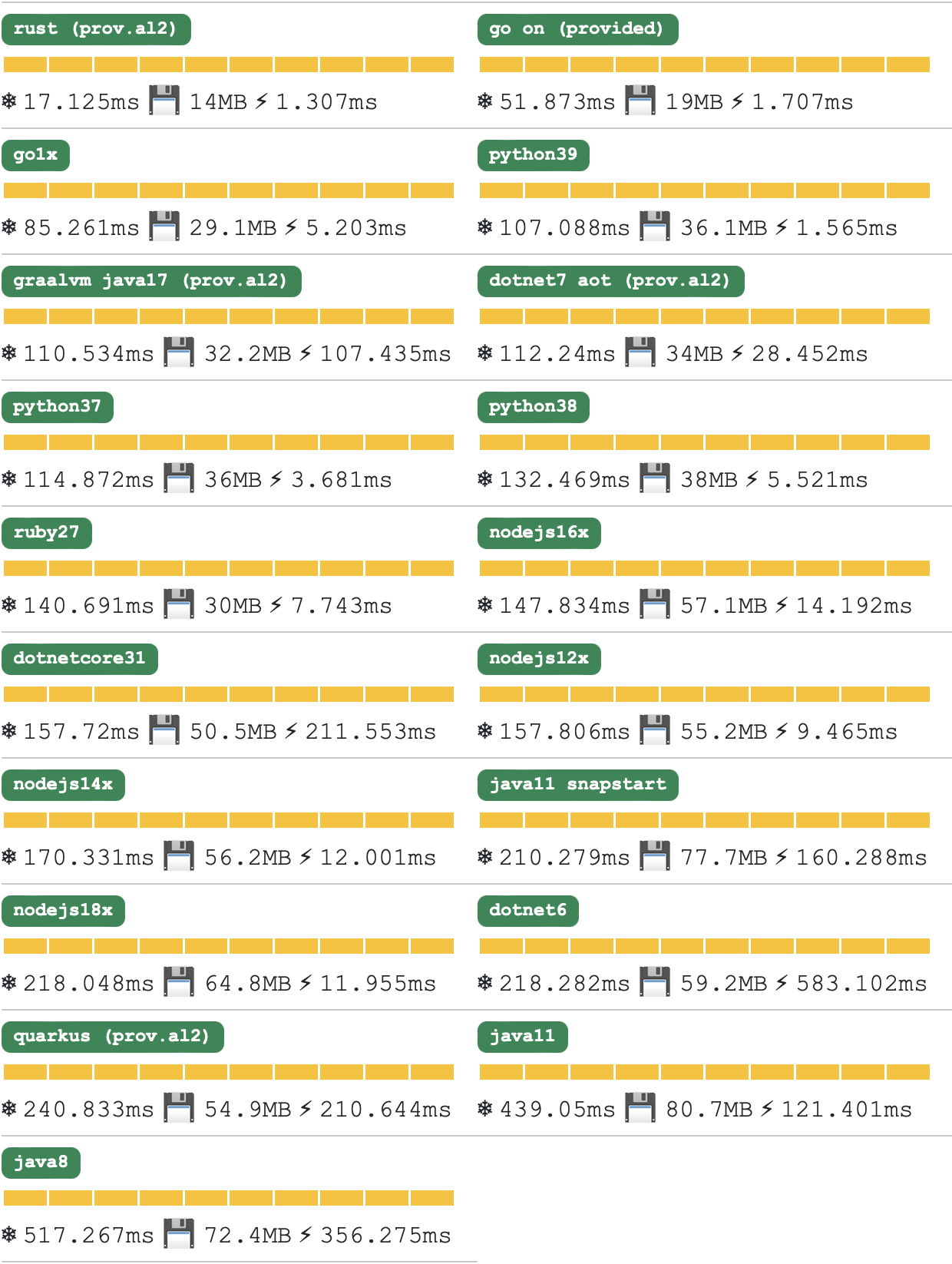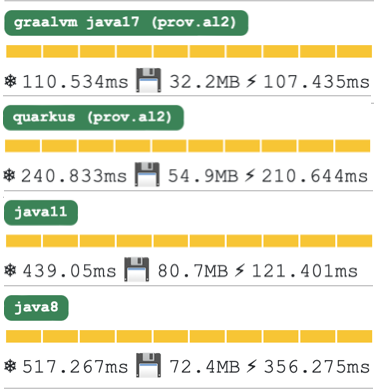
AWS Lambda with GraalVM
1. Purpose of this blog post
In the Lambda Cold Starts analysis by maxday page, we could see that Java on Lambda is really slow compared to :
-
Rust
-
Go
-
Python
-
NodeJS

I am a big fan of GraalVM, so I thought we could do better. To avoid you the need of reading a lot about GraalVM, I am going to give a small description.
GraalVM is a JVM created by Oracle in order to improve performance of languages that run on the JVM. It provides also the 'native-image' tool that transforms JVM applications into native executable.
That’s how we are going to improve the performance of the Java based lambda.
Important fact, GraalVM removes unused code and sometimes because of reflection it removes too much code.
2. Problem with GraalVM on a Lambda
Contrary to a Java Lambda that only need a class that implements com.amazonaws.services.lambda.runtime.RequestHandler, GraalVM needs an entry point. Meaning a main function to start the lambda.
It’s complicated to call directly the handleRequest method of our RequestHandler class because we don’t have access to com.amazonaws.services.lambda.runtime.Context.
3. The implementation
Fortunately for us, there is already a library to facilitate us the implementation of that : lambda Runtime GraalVM.
For our example, the handler is pretty simple and just return "ok".
The code is as follows :
package com.xavierbouclet;
import com.amazonaws.services.lambda.runtime.Context;
import com.amazonaws.services.lambda.runtime.RequestHandler;
public class OkHandler implements RequestHandler<String ,String>{
static {
System.setProperty("software.amazon.awssdk.http.service.impl",
"software.amazon.awssdk.http.urlconnection.UrlConnectionSdkHttpService");
}
@Override
public String handleRequest(String s, Context context) {
return "ok";
}
}And that’s it for tha Java code. The magic happens in the pom.xml file.
<?xml version="1.0" encoding="UTF-8"?>
<project xmlns="http://maven.apache.org/POM/4.0.0" xmlns:xsi="http://www.w3.org/2001/XMLSchema-instance"
xsi:schemaLocation="http://maven.apache.org/POM/4.0.0 http://maven.apache.org/xsd/maven-4.0.0.xsd">
<modelVersion>4.0.0</modelVersion>
<groupId>com.xavierbouclet</groupId>
<artifactId>graalvm-java17</artifactId>
...
<dependencies>
...
<dependency>
<groupId>com.formkiq</groupId>
<artifactId>lambda-runtime-graalvm</artifactId>
<version>2.0</version>
</dependency>
</dependencies>
...
<profiles>
<profile>
<id>native</id>
<build>
<plugins>
<plugin>
<groupId>org.graalvm.buildtools</groupId>
<artifactId>native-maven-plugin</artifactId>
<version>${graalvm.native.maven.plugin.version}</version>
<executions>
<execution>
<id>build-native</id>
<goals>
<goal>build</goal>
</goals>
<phase>package</phase>
</execution>
</executions>
<configuration>
<imageName>graalvm-java17</imageName>
<mainClass>com.formkiq.lambda.runtime.graalvm.LambdaRuntime</mainClass>
<buildArgs combine.children="append">
<!-- BouncyCastleAlpn issue tracked in https://github.com/netty/netty/issues/11369 -->
<buildArgs>
--verbose
--no-fallback
--initialize-at-build-time=org.slf4j
--initialize-at-run-time=io.netty.handler.ssl.BouncyCastleAlpnSslUtils
--enable-url-protocols=http
-H:ReflectionConfigurationFiles=${project.basedir}/src/main/resources/reflect.json
</buildArgs>
</buildArgs>
</configuration>
</plugin>
</plugins>
</build>
</profile>
</profiles>
</project>Like I said, we need to have a main class.
<plugins>
<plugin>
<groupId>org.graalvm.buildtools</groupId>
<artifactId>native-maven-plugin</artifactId>
<version>${graalvm.native.maven.plugin.version}</version>
...
<configuration>
...
<mainClass>com.formkiq.lambda.runtime.graalvm.LambdaRuntime</mainClass>
...
</configuration>
</plugin>
</plugins>The LambdaRuntime gives a main class com.formkiq.lambda.runtime.graalvm.LambdaRuntime that invokes everything we need to trigger our Lambda.
But using that we need to indicate to GraalVM that our OkHandler needs to stay in our final code. In order dto do that, we need to add a reflect.json that contains.
[
{
"name": "com.xavierbouclet.OkHandler",
"allDeclaredConstructors": true,
"allPublicConstructors": true,
"allDeclaredMethods": true,
"allPublicMethods": true
}
]And we need to indicate to GraalVM where to find the reflect.json file.
<plugin>
<groupId>org.graalvm.buildtools</groupId>
<artifactId>native-maven-plugin</artifactId>
<version>${graalvm.native.maven.plugin.version}</version>
...
<configuration>
...
<buildArgs combine.children="append">
<!-- BouncyCastleAlpn issue tracked in https://github.com/netty/netty/issues/11369 -->
<buildArgs>
--verbose
--no-fallback
--initialize-at-build-time=org.slf4j
--initialize-at-run-time=io.netty.handler.ssl.BouncyCastleAlpnSslUtils
--enable-url-protocols=http
-H:ReflectionConfigurationFiles=${project.basedir}/src/main/resources/reflect.json
</buildArgs>
</buildArgs>
</configuration>
</plugin>The build argument to indicate where to find the reflect"json file is H:ReflectionConfigurationFiles=${project.basedir}/src/main/resources/reflect.json.
To build our lambda, we need a Dockerfile :
FROM quay.io/quarkus/ubi-quarkus-mandrel-builder-image:22.3-java17 AS builder RUN curl https://dlcdn.apache.org/maven/maven-3/3.9.0/binaries/apache-maven-3.9.0-bin.tar.gz --output apache-maven-3.9.0-bin.tar.gz RUN tar xzf apache-maven-3.9.0-bin.tar.gz COPY src ./src COPY pom.xml . RUN ./apache-maven-3.9.0/bin/mvn package -Pnative # strip the binary FROM ubuntu as stripper RUN apt-get update -y RUN apt-get install -y binutils COPY --from=builder /project/target/graalvm-java17 /tmp RUN strip /tmp/graalvm-java17 # zip the extension FROM ubuntu:latest as compresser RUN apt-get update RUN apt-get install -y zip RUN mkdir /package WORKDIR /package COPY --from=stripper /tmp/graalvm-java17 /package/bootstrap RUN zip -j code.zip /package/bootstrap FROM scratch COPY --from=compresser /package/code.zip / ENTRYPOINT ["/code.zip"]
4. Conclusion

Our implementation with GraalVM gives better results than nodejs runtimes and python runtimes except the runtime python39. So it becomes a viable option if you want to keep Java code, but you still need performance. This lambda is really basic and doesn’t do anything, but it still gives us an interesting comparison of what performance we can have on AWS Lambda depending the runtime used.
In a future blog post, I will remove the library to control all the code added in the GraalVM executable.
If you want to check the code on GitHub.